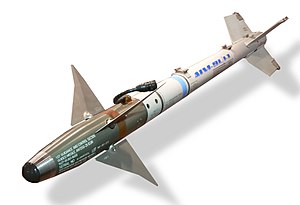| AIM-9 Sidewinder | |
|---|---|
 AIM-9L | |
| Type | Short range air-to-air missile |
| Place of origin | United States |
| Service history | |
| In service | 1956–present |
| Used by | See Operators |
| Wars | Second Taiwan Strait Crisis Vietnam War Yom Kippur War Iran–Iraq War Gulf of Sidra incident (1981) Falklands War 1982 Lebanon War 1989 air battle near Tobruk Gulf War Bosnian War *Banja Luka incident Operation Allied Force 2023 Chinese balloon incident Israel–Hamas war Red Sea crisis *Operation Prosperity Guardian |
| Production history | |
| Manufacturer | Raytheon Company[1] Ford Aerospace Loral Corp. Nammo |
| Unit cost | US$381,069.74 (Block II) US$399,500.00 (Block II Plus) US$209,492.75 (training missile) (All as of 2019[2]) |
| Produced | 1953–present |
| Specifications | |
| Mass | 188 pounds (85.3 kg)[1] |
| Length | 9 feet 11 inches (3.02 m)[1] |
| Diameter | 5 in (127.0 mm)[1] |
| Wingspan | 11 in (279.4 mm) |
| Warhead | WDU-17/B annular blast-fragmentation[1] |
| Warhead weight | 20.8 lb (9.4 kg)[1] |
Detonation mechanism | IR proximity fuze |
| Engine | Hercules/Bermite Mk. 36 solid-fuel rocket |
Operational range | 0.6 to 22 miles (1.0 to 35.4 km)[not verified in body] |
| Maximum speed | Mach 2.5+[1] |
Guidance system | Infrared homing (most models) Semi-active radar homing (AIM-9C) |
Launch platform | Aircraft, naval vessels, fixed launchers, and ground vehicles |
The AIM-9 Sidewinder ("AIM" for "Air Interception Missile")[3] is a short-range air-to-air missile. Entering service with the United States Navy in 1956 and the Air Force in 1964, the AIM-9 is one of the oldest, cheapest, and most successful air-to-air missiles.[4] Its latest variants remain standard equipment in most Western-aligned air forces.[5] The Soviet K-13 (AA-2 "Atoll"), a reverse-engineered copy of the AIM-9B, was also widely adopted.
Low-level development started in the late 1940s, emerging in the early 1950s as a guidance system for the modular Zuni rocket.[6][7] This modularity allowed for the introduction of newer seekers and rocket motors, including the AIM-9C variant, which used semi-active radar homing and served as the basis of the AGM-122 Sidearm anti-radar missile. Due to the Sidewinder's infrared guidance system, the brevity code "Fox two" is used when firing the AIM-9. Originally a tail-chasing system, early models saw extensive use during the Vietnam War, but had a low success rate (8% hit rate with the AIM-9E variant). This led to all-aspect capability in the L (Lima) version, which proved an effective weapon during the 1982 Falklands War and Operation Mole Cricket 19 in Lebanon. Its adaptability has kept it in service over newer designs like the AIM-95 Agile and SRAAM that were intended to replace it.
The Sidewinder is the most widely used air-to-air missile in the West, with more than 110,000 missiles produced for the U.S. and 27 other nations, of which perhaps one percent have been used in combat. It has been built under license by Sweden and other nations. The AIM-9 has an estimated 270 aircraft kills.[4]
In 2010, Boeing won a contract to support Sidewinder operations through to 2055. Air Force spokeswoman Stephanie Powell said that its relatively low cost, versatility, and reliability mean it is "very possible that the Sidewinder will remain in Air Force inventories through the late 21st century".[8]
- ^ a b c d e f g Sea Power (January 2006). Wittman, Amy; Atkinson, Peter; Burgess, Rick (eds.). "Air-to-Air Missiles". Sea Power. 49 (1). Arlington, Virginia: Navy League of the United States: 95–96. ISSN 0199-1337.
- ^ Parsch, Andreas (2024), Current Designations of U.S. Unmanned Military Aerospace Vehicles
- ^ a b "Raytheon AIM-9 Sidewinder". www.designation-systems.net. Archived from the original on 9 February 2010. Retrieved 2 February 2010.
- ^ Babcock, Elizabeth (September 1999). Sidewinder Invention and Early Years. The China Lake Museum Foundation.
The Air Force subsequently procured Sidewinder AIM-9B missiles for its hottest tactical and strategic aircraft, p. 21
- ^ Military Technology (August 2008). "News Flash". World Defence Almanac: The Balance of Military Power. 32 (8). Heilsbachstraße, Bonn-Germany: Mönch Publishing Group: 93–96. ISSN 0722-3226.
"Alliant Techsystems and RUAG Aerospace have signed a teaming agreement to provide full-service and upgrade support of the AIM-9P-3/4/5 Sidewinder family of IR-guided short-range air-to-air missiles.
- ^ "Air Weapons: Beyond Sidewinder". www.strategypage.com. Archived from the original on 3 February 2010. Retrieved 2 February 2010.
- ^ "April 9, 2004: 416th Flight Test Squadron Test Fires AIM-9X for the First Time From an F-16". Air Force Test Center. United States Air Force. 9 April 2021. Retrieved 7 January 2022.